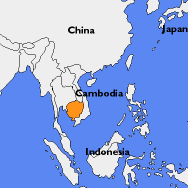|
Cambodia is a country in South East Asia, less than half the size of California and twice the size of Scotland. Once it was the centre of the ancient kingdom of the Khmer, and its capital was Angkor, famous for its 12th century temples. The present day capital is Phnom Penh. In 1953 Cambodia gained independence after nearly 100 years of French rule. In the 1960s the population was over 7m, almost all Buddhists, under the rule of a monarch, Prince Sihanouk.
In 1970 Prince Sihanouk was deposed in a military coup. The leader of the new right-wing government was lieutenant-general Lon Nol, who was made president of the 'Khmer Republic'. Prince Sihanouk and his followers joined forces with a communist guerrilla organisation founded in 1960 and known as the Khmer Rouge. They attacked Lon Nol's army and civil war began.
Cambodia was also caught up in another country's war. Cambodia's neighbour to the east is Vietnam, which had also fought against the French to gain independence. When the French were defeated in 1954, Vietnam was divided in two: communist North Vietnam and pro-Western South Vietnam (backed by the USA). Civil war immediately broke out. The Viet Cong, a group of Vietnamese communist guerrillas (backed by North Vietnam and China), based themselves in the jungles of South Vietnam and fought against the South Vietnamese army from there. In 1964, the USA entered the Vietnam war, with airpower, firebombs and poisonous defoliants, but found they could not budge the determined Vietnamese communists. The inconclusive war in Vietnam cost many American and Vietnamese lives, devastated the country, and achieved nothing but misery for anyone caught up in it, including the Cambodians.
Under Prince Sihanouk, Cambodia had preserved neutrality during the Vietnamese civil war by giving a little to both sides: Vietnamese communists were allowed to use a Cambodian port to ship in supplies, the USA were allowed to bomb - secretly and illegitimately - Viet Cong hideouts in Cambodia. When US-backed Lon Nol took over, US troops felt free to move into Cambodia to continue their struggle with the Viet Cong. Cambodia had become part of the Vietnam battlefield. During the next four years, American B-52 bombers, using napalm and dart cluster-bombs, killed up to 750,000 Cambodians in their effort to destroy suspected North Vietnamese supply lines.
The Khmer Rouge guerrilla movement in 1970 was small. Their leader, Pol Pot, had been educated in France and was an admirer of Maoist (Chinese) communism; he was also suspicious of Vietnam's relations with Cambodia. The heavy American bombardment, and Lon Nol's collaboration with America, drove new recruits to the Khmer Rouge. So did Chinese backing and North Vietnamese training for them. By 1975 Pol Pot's force had grown to over 700,000 men. Lon Nol's army was kept busy trying to suppress not only Vietnamese communists on Cambodian territory but also Cambodia's own brand of communists, the Khmer Rouge.
In 1975 North Vietnamese forces seized South Vietnam's capital, Saigon. In the same year Lon Nol was defeated by the Khmer Rouge. It's estimated that 156,000 died in the civil war - half of them civilians.
|
|
. |

